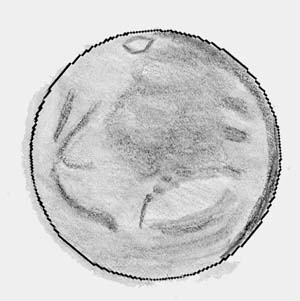
Sketched October 11, 2003 from my back deck in San Rafael, CA at 12:10 a.m. pacific DST (daylight savings time) or 07:10 UT October 11. Seeing excellent, transparency LM 4.0 - rising full moon.
| Date: 10/11/03 Lat 37N, Long 122W, elev. 200 feet | Sketch Time (UT): 7:10, (local time): 12:10 a.m. DST |
| Central Meridian: 37° | Filters: #82A, #80, #21, #25, #11 |
| Instrument: 4-inch (105mm) f/6 Astro-Physics Traveler Apo refractor. | Distance from earth 0.50 AU, 75m km, 47m miles |
| Magnification: (6mm) 252x Zeiss Abbe Ortho combined with a 2.4x AP Barcon Barlow | Transp. 4/6, Seeing 8/10, Antoniadi (I-V): I |
| Apparent Size: 18.6" | Magnitude: -1.8 |
Details about Mars: Diameter 18.6 arc seconds (Jupiter is about 30 -50 arc seconds in diameter depending on its distance from earth). Central Meridian 359 - the imaginary line passing through the planetary poles of rotation and bisecting the planetary disk, and is used to determine the longitude during an observing session. Mars' phase is now 93%.
Sinus Meridiani is on the central meridian in this sketch. Hellas is very bright near the south polar cap. two subtle lighter areas near the terminator are Agyrre I and Pyrrhae Regio. Mare Serpentis snakes around Hellas. Chryse is the light spot near the north polar region, terminator side.
Filters: I tried all my filters tonight. The #21 orange filter helped bring out features best. I observed Mars for about a half hour before each sketch to understand what I was seeing, and check maps, etc. Mars is 30 percent smaller and 13 million miles farther away than at opposition in late August, but still a wonderful object to observe and study.

White Oaks Home | Sketches Index | Mars 2003 Index | Back | Next